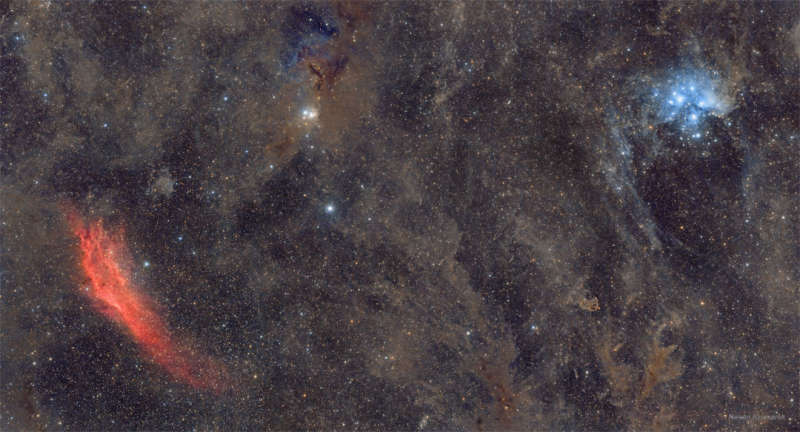Credit & Copyright: Neven Krcmarek
Explanation:
On the upper right, dressed in blue, is the
Pleiades.
Also known as the
Seven Sisters and
M45,
the Pleiades
is one of the brightest and
most easily visible
open clusters
on the sky.
The Pleiades
contains over 3,000 stars, is about 400 light years away, and only 13 light
years across.
Surrounding the stars is a spectacular blue
reflection nebula
made of fine
dust.
A
common legend is that one of the brighter stars
faded since the cluster was named.
On the lower left, shining in red, is the
California Nebula.
Named for its shape, the
California
Nebula is much dimmer and hence harder to see
than the Pleiades.
Also known as NGC 1499, this mass of red glowing
hydrogen gas is about 1,500 light years away.
Although about 25 full moons could fit
between them, the
featured wide angle, deep field image composite has captured
them
both.
A careful inspection
of the deep image will also reveal the star forming region
IC 348 and
the molecular cloud
LBN 777 (the Baby Eagle Nebula).
1999 2000 2001 2002 2003 2004 2005 2006 2007 2008 2009 2010 2011 2012 2013 2014 2015 2016 2017 2018 2019 2020 2021 2022 2023 2024 2025 |
Yanvar' Fevral' Mart Aprel' Mai Iyun' Iyul' Avgust Sentyabr' Oktyabr' Noyabr' Dekabr' |
NASA Web Site Statements, Warnings, and Disclaimers
NASA Official: Jay Norris. Specific rights apply.
A service of: LHEA at NASA / GSFC
& Michigan Tech. U.
|
Publikacii s klyuchevymi slovami:
California Nebula - Pleyady - pleiades
Publikacii so slovami: California Nebula - Pleyady - pleiades | |
Sm. takzhe:
Vse publikacii na tu zhe temu >> | |
